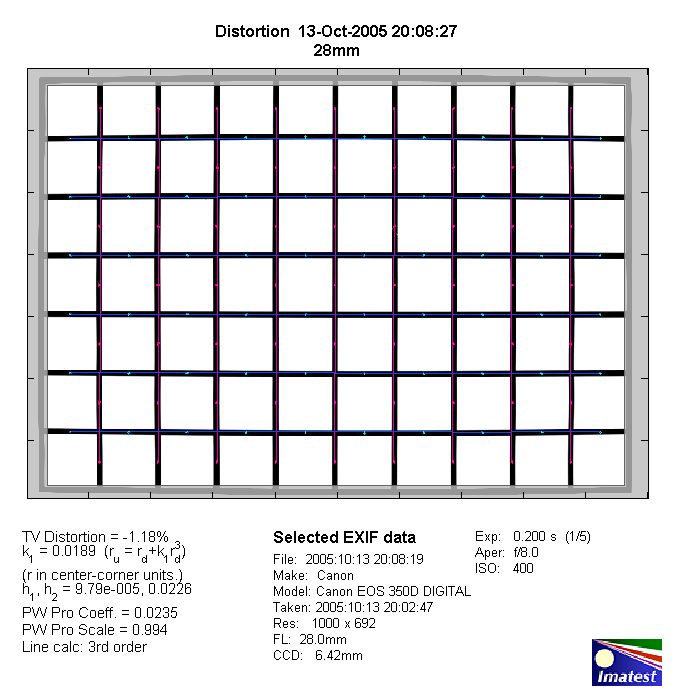|
Canon EF 28mm f/1.8 USM - APS-C Review / Re-Test - Analysis |
|
Lens Reviews -
Canon EOS (APS-C)
|
|
Page 2 of 2

Distortion
The lens shows a slight to moderate degree of barrel distortion (1.2%). This is comparatively good for a 28mm lens.

The chart above has a real-world size of about 120x80cm. It has been taken from the initial review of this lens. The distortion characteristic cannot change just by moving to a higher resolution DSLR of the same format.
Vignetting
On an APS-C DSLR the EF 28mm f/1.8 USM enjoys a sweet spot effect here and at ~0.7EV vignetting is low for such a large aperture lens. This is already very acceptable for the majority of shooting situations. If needed the issue can be basically completely eliminated when stopping down to f/2.2.

MTF (resolution)
Similar to the Sigma AF 30mm f/1.4 EX the Canon lens showed a rather mixed behavior in the lab. The center performance is already high straight from the max. aperture setting peaking in exceptional resolution figures around f/4. Unfortunately the border resolution lags quite a bit behind. At f/1.8 the borders are very soft. Stopping down help to gradually improve the resolution but even at f/8 the quality does not exceed good levels. At f/1.8 the lens also suffers from low contrast. This is slightly disappointing for a fairly modern prime lens.
There's a bit of a focus shift when stopping down (so-called residual spherical aberrations).
The centering quality of the tested sample was fine.
Please note that the MTF results are not directly comparable across the different systems!
Below is a simplified summary of the formal findings. The chart shows line widths per picture height (LW/PH) which can be taken as a measure for sharpness.
If you want to know more about the MTF50 figures you may check out the corresponding Imatest Explanations
Chromatic Aberrations (CAs)
CAs (visible as color shadows at harsh contrast transitions) can reach an average CA pixel width of more than 2 pixels at the image borders - a very weak performance here. CAs can be reduced and usually even eliminated via imaging tools but a prime lens should definitely perform better than that.
On our 15 megapixel test camera, the CA values are comparable to our initial review (performed at 8 megapixels). This is a bit surprising because there should be a scaling effect here (the present test is based on a 15 megapixel DSLR) - possibly a sample variation issue.

Verdict
The Canon EF 28mm f/1.8 USM disappoints on the APS-C format. It is a full format lens yet the border quality leaves something to be desired even when stopped down. The fairly heavy amount of lateral CAs reduces the subjective quality perception even further. However, the center quality is actually very good. From a real world perspective this characteristic may still be fine. The border quality is usually not a top priority at very large aperture settings and at f/8 it may be "good enough". There is a bit of light falloff at f/1.8 but it's not overly disturbing and already gone when stopping down a tiny bit. The level of distortion is good. The bokeh (quality of the out-of-focus blur) of the lens is quite rough but that's rather typical in this lens class. Really nice aspects are the high build quality plus the silent and fast AF. The pricing is pretty low in absolute terms although you may debate whether it is a good offer from a price/performance perspective.
|